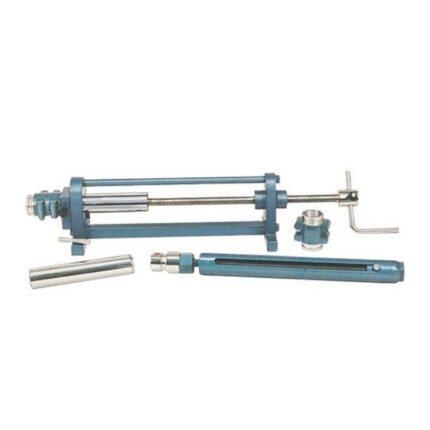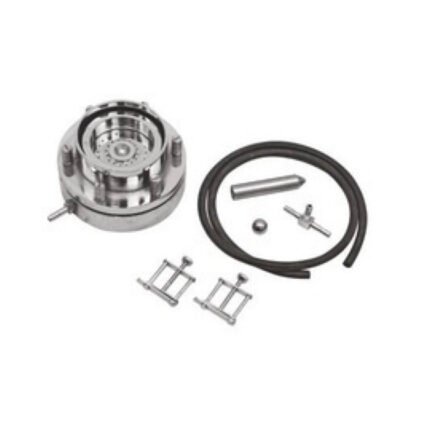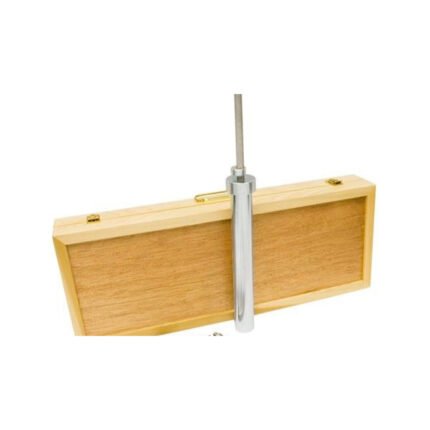AZA 0896 CONSOLIDATION APPARATUS (FRONT LOADING TYPE)
- Front Loading Consolidation Apparatus: Ergonomic design for easy placement and removal of consolidation cell.
- Soil Consolidation Testing: Essential for predicting the settlement of structures on soil.
- User-Friendly Operation: Simplifies the setup and execution of oedometer tests.
- Accurate Data: Ensures precise measurement of soil deformation under load.
- Robust Construction: Durable frame for long-lasting performance in geotechnical testing laboratories.
- Azalab Quality: Reliable equipment for comprehensive soil consolidation analysis.
Description
AZA 0896: Front Loading Consolidation Apparatus for Streamlined Soil Settlement Analysis
The AZA 0896 Consolidation Apparatus (Front Loading Type) from Azalab offers a practical and efficient solution for geotechnical testing laboratories involved in determining the compressibility and soil consolidation characteristics of various soil types. This front loading design significantly improves the ergonomics and ease of use compared to traditional top-loading oedometer setups, making the placement and removal of consolidation cells more straightforward and less cumbersome for laboratory technicians. Understanding soil consolidation is critical in civil engineering to accurately predict the long-term settlement of foundations, embankments, and other structures, thereby ensuring their stability and serviceability.
The consolidation test, also known as the oedometer test, involves subjecting a laterally confined soil specimen to a series of increasing vertical loads and meticulously measuring the resulting vertical deformation over time. The data derived from these tests is instrumental in calculating key soil parameters such as the coefficient of consolidation (c_v), compression index (C_c), swelling index (C_s), and the preconsolidation pressure (p′_c). These parameters are fundamental for predicting both the magnitude and the rate of settlement, enabling engineers to design more reliable and cost-effective civil infrastructure. The AZA 0896 Front Loading Consolidation Apparatus facilitates the precise execution of these vital tests.
The primary advantage of the front loading mechanism in the AZA 0896 is the improved accessibility to the consolidation cell. This design streamlines the entire testing process, from sample preparation and cell placement to test initiation and termination. The apparatus typically features a sturdy loading frame, a lever arm system for applying incremental loads via dead weights, and a platform for placing the consolidation cell. While the standard configuration usually includes a mechanical dial gauge for measuring vertical deformation, the AZA 0896 can often be upgraded with electronic displacement transducers (LVDTs) and a data logging system. This electronic upgrade further enhances accuracy, provides real-time digital readouts, and enables automated data acquisition for more efficient analysis and reporting.
Azalab’s commitment to quality ensures that the AZA 0896 Front Loading Consolidation Apparatus is built with robust materials and precision components, providing long-term durability and consistent performance in demanding laboratory environments. It is designed to meet or exceed relevant international standards for soil consolidation testing, including ASTM D2435 (Standard Test Methods for One-Dimensional Consolidation Properties of Soils) and BS 1377-5 (Methods of test for soils for civil engineering purposes. Compression and swelling tests). For a deeper understanding of consolidation theory and its applications in geotechnical engineering, valuable resources can be found in academic textbooks and publications from professional bodies such as the American Society of Civil Engineers (ASCE) or by exploring concepts like “Terzaghi’s one-dimensional consolidation theory.”
By integrating the AZA 0896 Consolidation Apparatus (Front Loading Type) into your geotechnical testing laboratory, you benefit from an ergonomic, efficient, and reliable instrument that delivers precise data for critical soil consolidation analysis. This ultimately leads to more confident foundation designs and safer, more stable civil engineering projects.
Specifications for the AZA 0896 Consolidation Apparatus (Front Loading Type)
- Model Number: AZA 0896
- Test Type: Soil Consolidation (One-Dimensional Consolidation / Oedometer Test)
- Loading Type: Front Loading mechanism for easy cell placement and removal.
- Loading System: Dead weight and lever arm system for incremental load application.
- Load Ratio: Typically 10:1 or 1:1, ensuring precise application of normal stresses.
- Consolidation Cell: Accommodates standard consolidation cells (oedometer rings), common sizes include 50 mm, 63.5 mm, or 75 mm diameter.
- Deformation Measurement:
- Standard: Mechanical dial gauge (e.g., 10 mm or 25 mm travel, 0.01 mm resolution).
- Optional: Electronic LVDT transducer with digital display and data logging capability for enhanced accuracy and automation.
- Normal Load Capacity: Varies, typically designed to apply loads up to 1000 kPa or more.
- Material Construction: Robust steel frame, precision-machined brass or stainless steel consolidation cell and components.
- Compliance: Designed to meet international geotechnical testing standards (e.g., ASTM D2435, BS 1377-5).
- Dimensions: Benchtop footprint, designed for stability.
- Weight: Substantial, to ensure stable load application.
FREQUENTLY ASKED QUESTIONS (FAQ) about the AZA 0896
Q1: What is the main advantage of the “Front Loading Type” design of the AZA 0896? A1: The front loading design of the AZA 0896 significantly improves ergonomics, making it much easier and more convenient to place and remove the consolidation cell and soil sample compared to traditional top-loading models.
Q2: What is the primary purpose of the AZA 0896 Consolidation Apparatus? A2: The AZA 0896 is used to perform soil consolidation (oedometer) tests, which determine the compressibility characteristics of soil and are essential for predicting the long-term settlement of structures.
Q3: What soil parameters can be determined using this apparatus? A3: This Consolidation Apparatus allows for the determination of critical parameters such as the coefficient of consolidation (c_v), compression index (C_c), swelling index (C_s), and the preconsolidation pressure (p′_c).
Q4: Can the AZA 0896 be upgraded for electronic data acquisition? A4: Yes, the AZA 0896 can typically be upgraded with electronic LVDTs and a data logging system for automated, high-precision measurement and recording of deformation data, enhancing its capabilities for geotechnical testing.
Q5: What types of soil can be tested with the AZA 0896? A5: The AZA 0896 is suitable for testing a wide range of cohesive soils, such as clays and silts, both undisturbed and remoulded, that can be prepared within the consolidation cell.
Q6: What maintenance is required for the AZA 0896 Front Loading Type? A6: Regular maintenance includes keeping the apparatus clean, ensuring the lever arm and loading system operate smoothly, and periodically calibrating the dial gauge or electronic transducers to maintain accuracy in your soil consolidation tests.
Q7: Is this apparatus suitable for both educational and commercial laboratories? A7: Yes, its user-friendly front loading design and robust construction make the AZA 0896 suitable for both educational institutions, where ease of use is beneficial for students, and commercial laboratories requiring reliable geotechnical testing equipment.
Additional information
| Model Number |
AZA 0896 |
|---|---|
| Test Type |
Soil Consolidation (One-Dimensional Consolidation / Oedometer Test) |
| Loading Type |
Front Loading mechanism for easy cell placement and removal. |
| Dimensions |
Benchtop footprint, designed for stability. |
| Weight |
Substantial, to ensure stable load application. |
Related products
AZA 0853 LIQUID LIMIT DEVICE WITH COUNTER
AZA 0857 PARTICLE SIZE SEDIMENTATION (HYDROMETER METHOD)
- Particle size distribution using hydrometer sedimentation
- Suitable for clays and silts below 75 microns
- Conforms to IS 2720 Part IV & ASTM D422
- Includes hydrometer, sedimentation cylinder, thermometer
- Accurate readings of soil particle settlement over time
- Ideal for soil mechanics, civil and geotechnical labs
AZA 0860 METHYLENE BLUE TEST SET
- Determines clay content in fines and aggregates
- Based on Methylene Blue Value (MBV) method
- Complies with ASTM C837 and EN 933-9 standards
- Includes digital burette, conical flask, filter paper, and stirrer
- High sensitivity to montmorillonite and other clays
- Ideal for geotechnical, concrete, and aggregate testing labs
AZA 0861 MOTORISED SAND EQUIVALENT SHAKER
AZA 0863 STANDARD COMPACTION TEST
- Standard Compaction Test: Specifically designed to perform the Standard Proctor Compaction Test.
- Fundamental Soil Property: Determines the maximum dry density and optimum moisture content of soils.
- Essential for Earthwork: Crucial for quality control in road construction, embankments, and foundations.
- Complete Apparatus: Includes a robust compaction mould, standard rammer, and necessary accessories.
- Standard Compliant: Adheres to international standards such as ASTM D698 and equivalent IS/BS norms.
- Azalab Quality: Durable and precise equipment for reliable geotechnical testing results.
AZA 0865 HEAVY COMPACTION TEST
- Heavy Compaction Test: Specifically designed to perform the Modified Proctor Compaction Test.
- High Compaction Energy: Utilizes a heavier hammer and greater drop height for higher soil density requirements.
- Crucial for Critical Projects: Essential for quality control in heavy civil engineering applications like airfields and high-stress pavements.
- Complete Apparatus: Includes a robust compaction mould, heavy rammer, and necessary accessories.
- Standard Compliant: Adheres to international standards such as ASTM D1557 and equivalent IS/BS norms.
- Azalab Quality: Durable and precise equipment for reliable geotechnical testing results.
AZA 0868 PROCTOR NEEDLES (SPRING TYPE)
AZA 0872 DYNAMIC CONE PENETROMETER
- Dynamic Cone Penetrometer (DCP): Essential for rapid in-situ testing of soil strength and compaction.
- Pavement Evaluation: Ideal for assessing subgrade, sub-base, and base course layers in road construction.
- Direct Readout: Provides immediate penetration resistance data, correlating to CBR values.
- Portable & User-Friendly: Lightweight and easy to operate, suitable for various field conditions.
- Robust Construction: Durable components for long-lasting performance in demanding geotechnical testing.

 Rock
Rock Aggregate
Aggregate Cement
Cement Concrete
Concrete Soil
Soil Steel
Steel Bitumen/Asphalt
Bitumen/Asphalt Security Survey Equipment
Security Survey Equipment General Items
General Items











